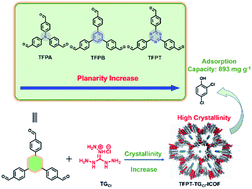A knot-linker planarity control strategy for constructing highly crystalline cationic covalent organic frameworks: decoding the effect of crystallinity on adsorption performance†
Abstract
Ionic covalent organic frameworks (iCOFs), a subclass of COFs, offer a functional platform for diverse applications. However, strong charge repulsion between adjacent layers often leads to low-crystalline iCOFs. Herein, we report a knot-linker planarity control strategy to synthesize a highly crystalline iCOF with C3-symmetric cationic units. More planarity of building blocks gives higher crystallinity of iCOFs, leading to a larger surface area and more exposed binding sites of iCOFs. The highly crystalline iCOF in turn gives larger uptake capacity and faster kinetics than the low-crystalline iCOF and the non-crystalline iCOF, uncovering the significance of crystallinity for the removal of pollutants. The prepared highly crystalline TFPT–TGCl–iCOF exhibits larger saturation sorption capacity (893 mg g−1) than previous adsorbents for 2,4-dichlorophenol. The developed strategy provides a new way to construct highly crystalline iCOFs with C3 symmetric-type cationic sites for various applications.



 Please wait while we load your content...
Please wait while we load your content...